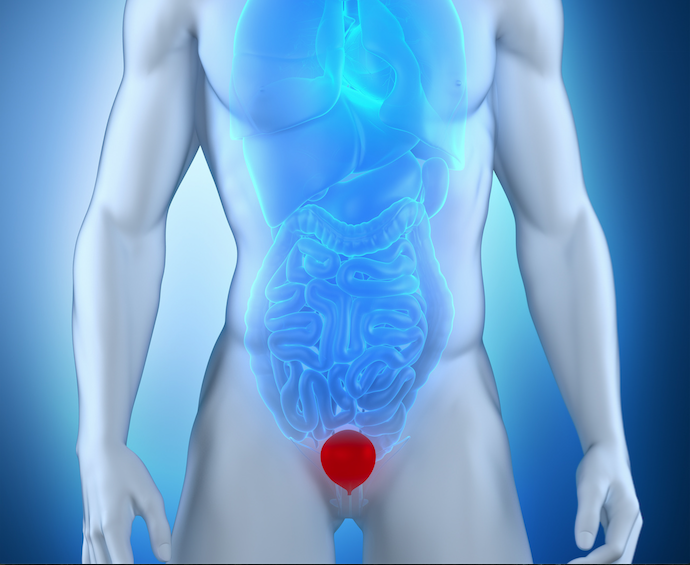Hypopressive exercises are commonly practiced by moms after pregnancy to prevent or treat pelvic floor dysfunctions such as urinary incontinence or prolapse. However, little is known about the treatment of pelvic floor problems in males and the benefits that a Low pressure exercise program can provide…specifically after radical prostatectomy. In the following article we will approach the topic of prostate; rehabilitation of urinary incontinence when the prostate is removed and the evidence of hypopressive exercise available for the moment.
First of all… what is the prostate?
The prostate is the reproductive gland that produces the liquid that carries sperm during ejaculation. This gland surrounds the urethra, the tube through which carries urine out of the body. So, the prostate forms part of the male reproductive system.
It is approximately the size of a walnut. In addition to surrounding the urethra, it produces the liquid responsible for carrying the sperm during ejaculation. As such, it has a dual function.
Urinary: allows the flow of urine from the bladder
- Sexual reproduction: allows the flow of semen.
Over time, especially after age 50, the prostate starts to increase in size. This phenomenon is known as benign prostate hypertrophy. The prostate can increase in size but this hypertrophy is not synonymous with cancer, although men are advised to have annual medical check-ups. The expansion or growth of the prostate can obstruct other neighboring organs like the urethra, causing possible urinary problems or kidney damage.
So…what are the problems related to the prostate?
This increase in size of the prostate provokes various symptoms related to this benign prostate hypertrophy. It is not a illness but it can affect the quality of life of men. The most common symptoms are:
- Slow urination
- Frequent night-time urination
- Problems related to bladder emptying
- Urgent urinary incontinence
- Urinary incontinence
Another frequent problem is prostatitis, which is inflammation of the prostate. This affliction can irritate the prostate.
Some of the most frequent symptoms of prostatis are:
- Tiredness
- Fever
- Urgent urination
- Pain when urinating
Unfortunately, another significant problem is prostate cancer. This disease does not usually produces symptoms or if symptoms do occur they are similar to Prostatic Hypertrophy. Therefore, symptoms of prostate cáncer can appear in periodic check-ups when blood appears in the urine.
Prevention is better than cure
Given that life expectancy is increasing, it should be taken into account that the best treatment is prevention. In addition to annual medical check-ups, following basic patterns of care may be essential prevent and even to treat prostate problems.There exist suitable conservation treatments to address the symptomology of the Benign Prostate Hyperplasy related to lifestyle habits and physiotherapy treatment. With this treatment plan, the following stand out:
- Healthy and balanced diet. Healthy eating, with a high vegetable content and less meat and animal products (linked to cancerous processes)
- Not smoking!
- Pelvic floor muscle training
- Engaging a moderate physical exercise program like Low Pressure Fitness
Why Low Pressure Fitness can help in the prevention of problems related to the prostate?
The recent popularity that Low Pressure Fitness has attained in Europe is due to the excellent results that hundreds of practitioners have achieved with this exercise program. Many health professionals including physiotherapists and doctors are starting to recommend Low Pressure Fitness as a suitable exercise program for prostate problems. Other popular workouts which involve exercises like running, jumping, and heavy lifting increase intraabdominal pressure, so they also increase intraabdominal pressure towards the urethra. The prostate can get a Little “angry”, if it feels too compressed. Low pressure fitness acts just in the opposite way “sucking or kissing” the prostate. This happens because one of the major effects of LPF is the visceral decompression that is exerted due to the strong diaphragmatic aspiration. This can be of great help in the case, for instance, of the pressure that the prostate exerts on the bladder. Furthermore, with LPF the pelvic muscles are strengthened, alleviating the symptoms of urgent urination and bladder emptying.
The expert physiotherapist in uro-gynaecology approaches different therapies for disorders of the pelvic floor both female as well as male. The re-training of the pelvic floor musculature is fundamental for the tackling of the afore mentioned disorders.
In this way, they use a combination of tools such as electrotherapy biofeedback, pelvic floor muscle training and more recently the hypopressive technique used in the training program of Low Pressure Fitness.
Hypopressive exercises are a novel approach to pelvic floor muscle training. They are postural and breathing exercises which engage the abdominal transverse with concious coordination of the diaphragm that is hypothesized to decrease pelvic pressure and cause subsequently cause urethral constriction. Another benefit to mention about the hypopressive technique of LPF is the increase in the vascular blood flow. The microcirculation increases with the diaphragmatic suction and this, aided by pelvic unblocking, is an important factor to the prevent undesired prostate problems.
Clinical Evidence for male urinary incontinence and Hypopressives?
Several clinical rehabilitation protocols for for prostate cancer post-operation patients, have included hypopressive exercises in their rehabilitation exercise protocol with promising results¡¡ Here are some examples:
Also very interesting the study protocol proposed by Santa Mina et al. (2015) at the Journal BMC UROLOGY “A pilot randomized trial of conventional versus advanced pelvic floor exercises to treat urinary incontinence after radical prostatectomy: a study protocol”.
To sum up, there is a growing interest by the literature and urologic specialists of hypopressive exercises and it´s possible effects on urinary incontinence after radical prostatectomy. The preliminary results of the previous studies show that this can be a novel approach for pelvic and core muscle global training.
